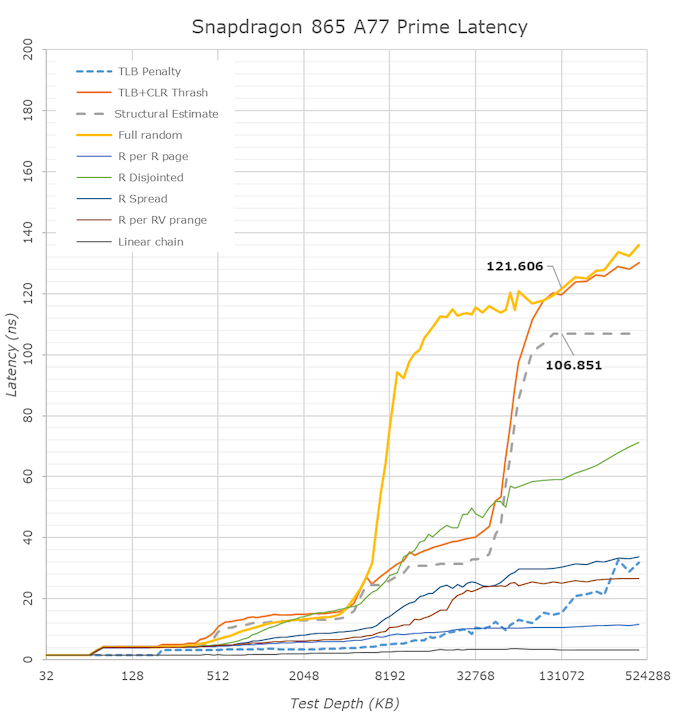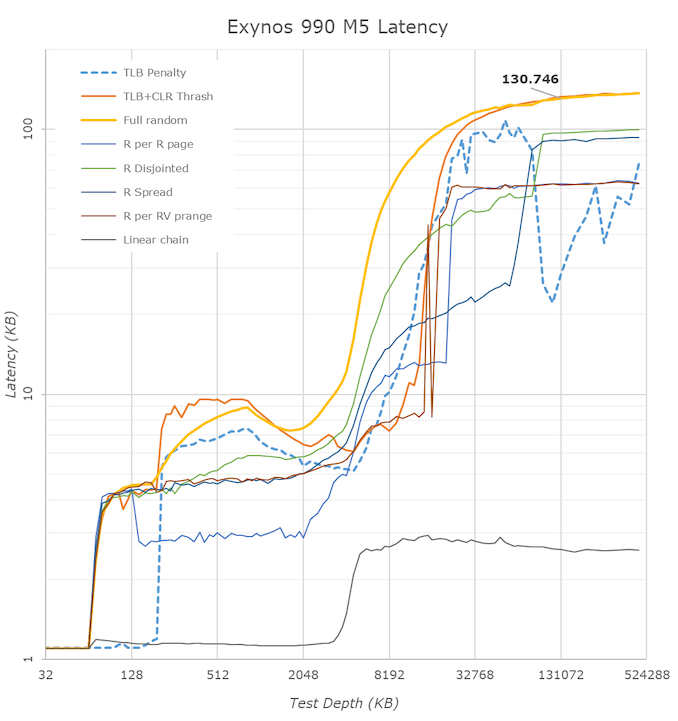The Samsung Galaxy S20+, S20 Ultra Exynos & Snapdragon Review: Megalomania Devices
by Andrei Frumusanu on April 3, 2020 9:30 AM ESTMemory Subsystems Compared
On the memory subsystem side, there’s quite a few big changes for both the Snapdragon 865 as well as the Exynos 990, as these are the first commercial SoCs on the market using LPDDR5. Qualcomm especially is said to have made huge progress in its memory subsystem, and we’re now able to verify the initially promissing results we saw on the QRD865 back in December with a production device.
And indeed, the news keeps on getting better for Qualcomm, as the new Galaxy S20 showcases even better memory results than we had measured on the reference device. The improvements over the Snapdragon 855 are just enormous and Qualcomm not only manages to catch up but very much now is able to beat the Exynos chips in terms of memory subsystem performance.
Arm very famously quotes that an improvement of 5ns in memory latency corresponds to an increase of around 1% in performance. And if that’s the case, Qualcomm will have had a ~12% improvement in CPU performance just by virtue of the new memory controller and SoC memory subsystem design. Our structural estimate in the memory latency falls in around 106 vs 124ns – most of the improvement seems to be due to how Qualcomm is now handling accesses to the DRAM chips themselves, previously attributing the bad latencies on the Snapdragon 855 due to power management mechanisms.
Samsung’s Exynos 990 also improves in memory latency compared to the Exynos 9820, but by a smaller margin than what the Snapdragon 865 was able to achieve. All latency patterns here are still clearly worse than the Qualcomm chip, and there’s some oddities in the results. Let’s zoom in into a logarithmic graph:
Comparing the Exynos 990 results vs the Exynos 9820, it’s now quite visible that the L2 cache has increased dramatically in size, similar to what we’ve described on the previous page, corresponding to the doubling of the available cache to a core from 1MB to 2MB. Samsung’s cores still have some advantages, for example they’re still on a 3-cycle L1 latency design whereas the Arm cores make due with 4-cycle accesses, however in other regards, the design just falls apart.
The TLB issues that we had described last year in the M4 are still very much present in the M5 core, which results in some absurd results such as random accesses over a 2MB region being actually faster than at 1MB. Cache-line accesses with TLB miss penalties now actually have lower access latencies in the L3 than in the L2 regions, and I have no idea what’s happening in the 16-64MB region in that test as it behaves worse than the 9820.
Examining the A76 cores of the Exynos 990, we see a much cleaner set of results more akin to what you’d expect to see from a CPU. Here we also see the 2MB SLC cache hierarchy in the 1-3MB region, meaning the Arm core cluster does have access to this cache, with the M5 cores bypassing it for better latency. Last year I had noted that the A76’s prefetchers had seen some massive improvements, and this is again evident here in the result sets of the two CPUs on the same chip as the middle cores actually handle some access patterns better than the M5 cores.
Samsung has had large issues with its memory subsystem ever since the M3 design, and unfortunately it seems they never addressed them, even with the more recent M5 core.
The Snapdragon 865 here is quite straightforward. The biggest difference to the 855, besides the improved DRAM latency, is the doubling of the L3 from 2 to 4MB which is also immediately visible. It still pales in comparison to the Apple A13’s cache hierarchy, but we do hope that the Arm vendors will be able to catch up in the next few years.













137 Comments
View All Comments
iSeptimus - Sunday, April 12, 2020 - link
They really don't. 2 years max on updates and the security patches only come out when it is critical after that.My Galaxy Fold only just got One UI 2.1 and Android 10. The most expensive phone they do and they are already slowing down updates for it. Samsung suck at software.
MAGAover9000 - Tuesday, April 7, 2020 - link
Sounds like a positive TBH. I hate some of the updates.Omega215D - Friday, April 3, 2020 - link
That's for the maxed out S20 Ultra, what S10 are you comparing it to? There are the following additions to the S20 lineup: camera tech, 5G, battery capacities, mobile chipsets, display tech, etc. Now not everyone may find those attractive enough to jump on board that doesn't mean they have to buy the damn thing.Threska - Friday, April 3, 2020 - link
5G is probably the biggest push for cost, since 5G phones usually run in the $1,000 range.Andrei Frumusanu - Friday, April 3, 2020 - link
The Galaxy S20 and S20+ 4G variants have the same launch prices as S10 and S10+ - with the only caveat being that they're only available in certain markets, with the US missing from that list.So in that sense, the only thing you're paying extra for is the 5G.
FunBunny2 - Friday, April 3, 2020 - link
"5G phones usually run in the $1,000 range"I still don't get why anyone would pay for "5G". mmWave is barely extant. Verizon, for one, adverts pump up use in football stadiums (if we ever have such), 'so it must be great for you' kind of thing. while sub6 is barely perceptibly different LTE. Why? If there's ever a true build out of mmWave, it'll be in suburban subdivisions with plenty of street lights, no longer the norm. In cities, you'll need some sort of '5G' wifi inside any kind of building with a (massive?) dish on the roof. Ah cannaw change da laws of physic, capn.
shabby - Friday, April 3, 2020 - link
We don't have a choice, Qualcomm is forcing it onto us.s.yu - Friday, April 3, 2020 - link
Qualcomm's going with the flow of the industry, there's no way but forward ;)But anyway, the Luneburg lenses China Mobile showcased, if they're compatible with mmWave, and if they're even willing to sell them(the issue is cost and somehow they're able to make them much cheaper, cheap enough for civilian use), then they could drastically increase coverage at essentially the same power levels.
PeachNCream - Friday, April 3, 2020 - link
Yup, that's a lot to pay for something that you carry around on a daily basis and expose to the outdoor world including weather, impact, and theft. I know the TELCOs are hiding the cost inside monthly payments over the life of a contract so most buyers will not take note of the price over say an $800 dollar handset, but wow people are forking over a lot of their earnings just to carry around a status symbol that other people will stop caring about after a couple of months.FunBunny2 - Friday, April 3, 2020 - link
"wow people are forking over a lot of their earnings just to carry around a status symbol"why does a Ferrari cost 3 times a Ford (not the GT, of course)? because the capital investment to make either is nearly the same, but spread out over a fraction of units. same with "5G" phones. the capital to make all those specialized bits and pieces, whether Samsung made or bought it, is about the same, but separate, from the capital to make a moto G6, etc. but far fewer units. unlike the march to LTE, "5G" is more likely to be a toddler's waddle. with sky high prices as an added benefit.
there was a headline recently that the Swiss watch industry is on a ventilator, few have any need for such bling. can the bling smartphone be far behind? at least your scion can use that Patek Philippe in 50 years.